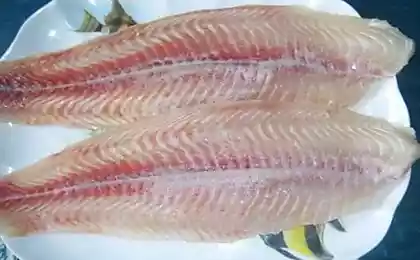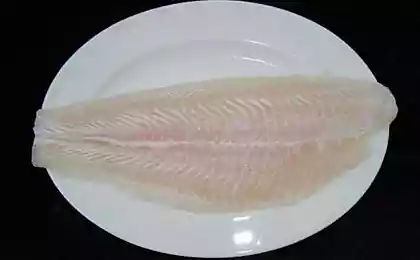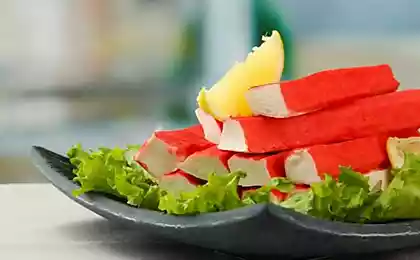1094
Guide seafood: Pangasius
via: the-fencer
27 photos + a bit of letters. End outline the
Hello my dear true friends! From today, I (as promised) begin to share with you information about fish and seafood. And because the comments I was asked to start from pangasius - begins with him.
Roughly all imported fish can be divided into two categories: wild (hake, hoki, kingklip, pollock, etc.) and farmed (salmon, sea trout (that which Oncorhynchus mykiss), tilapia, catfish and Taiwan, etc.) . Pangasius belongs to the second group, and is probably the most massive artificially produced fish. In the original photo as the time it is (similar to some river pig - but not the pig snout penny).
Pangasius (this is also important) is a freshwater fish and is produced mainly in Vietnam. Without exception, all production (all without exception, companies monsters) are located in the Mekong Delta.
About twenty years ago in Vietnam it began production of pangasius farming, although it was oriented to the domestic market (which is not surprising when more than eighty million population). Eleven years ago, we began to export pangasius, which is very beneficial to the industry: over the years the company emerged in Vietnam concentrate in their hands a complete production cycle (from fry to the final product) and a population of twenty thousand workers in the season.
Immediately apologize for the quality of photos shot exclusively for themselves and not rely on the fact that I ever have to publish them.
Mekong - to put it mildly is not the cleanest river. Swim there, I would not dare. Perhaps this is one of the reasons due to which the pangasius in the world is very cautious attitude.

...
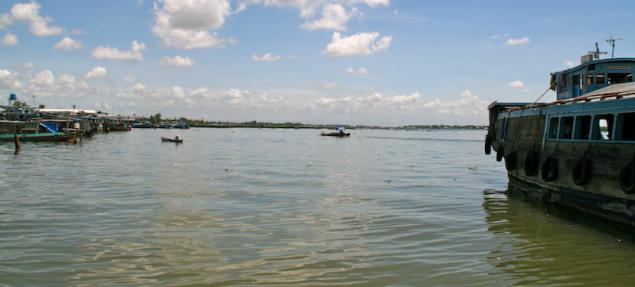
...

...
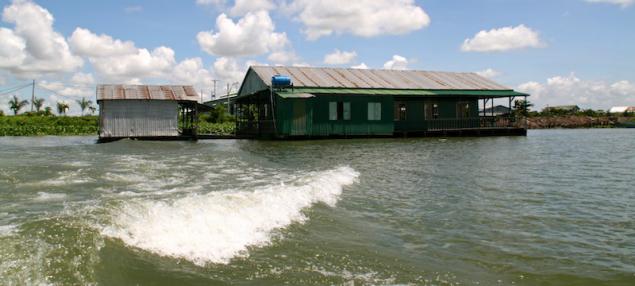
Water for the production of pangasius really taken from the Mekong, but the fish are not growing in the river, and in a specially dug ponds. There it is cleaned and aerated. Ponds of great variety.

Like any farming fish pangasius feed special pellets. The composition of the pellets include fish waste (which in general is normal, because the fish in the river and the sea eats other fish without harm to health), minerals, and often wastes from the production of sunflower oil (in common - cake). At the time, I was pretty surprised when I learned that one of Norway's largest manufacturers of feed for fish farming, imports cake (thousands of tons) from Ukraine.
Unlike Norway and Chile, where kormёzhka done automatically (or semi-automatic) process in Vietnam everything is done manually. Bags of food are loaded on a raft.
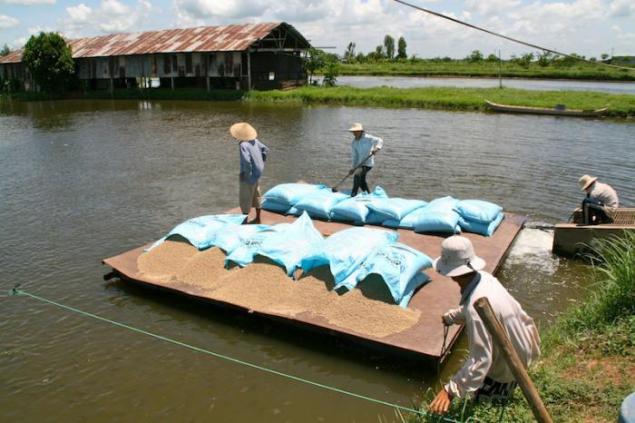
Severe Vietnamese men pull the raft in the middle of the pond.
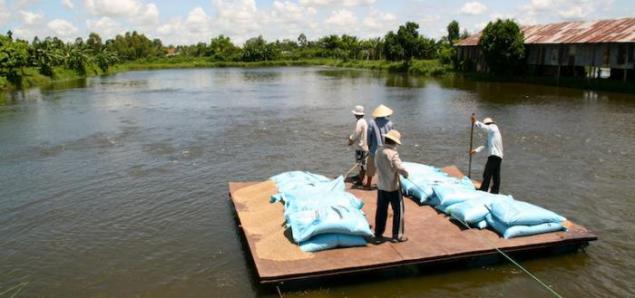
Then start throwing shovels pellets into the water.
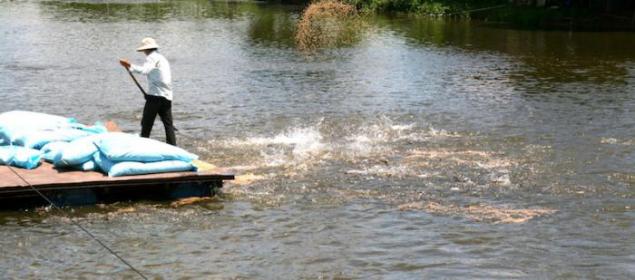
The water at this moment begins a natural way to "boil" of wanting to eat. Oh, they know what they are fed ...

...

...

...

Pangasius - a fast growing fish. Unlike salmon, which from the time of planting the fry into the water, to the bottom grows two to three years, Pangasius grows only six months. After dialing the required weight, the fish is removed from the pond and in a specially equipped car (all this time the fish is in the water, which is fed oxygen) supply to the factory.
It looks something like this:

Almost all operations are carried out manually. This Vietnamese plants like the Chinese (as opposed to Norway, where mechanized almost everything).

Pangasius clog specially trained guys with knives. One shot somewhere near the gills - and the fish die in a special boiler with chilled water. After that, other specially trained men cut fish fillets. Filleting pound fishes usually takes two or three seconds. Head with ridges or melyatsya flour, or used for the production of the same fish feed.
In all plants the most severe sanitary norms. Clean incredible. Any European client who comes to inspect production, looks somewhere so (for clarity, placed next to the representative of the indigenous people):

Biorobot:

...
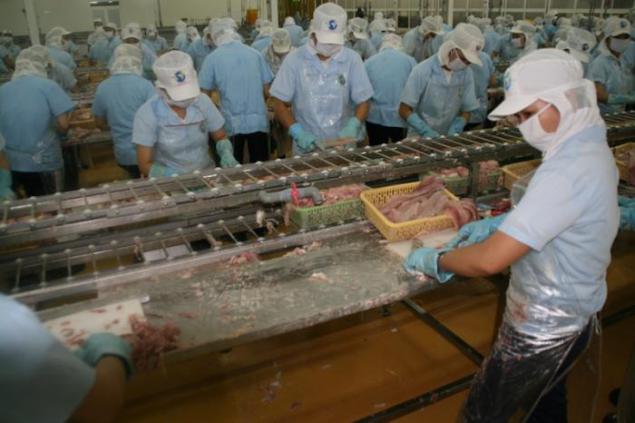
One of the few operations that are not done by hand: the removal of the skin from the fillets. Sliced manually fillet served here, and the two lad put him on a special roll. The skin is not always cut cleanly, then it was trimmed by hand.

...
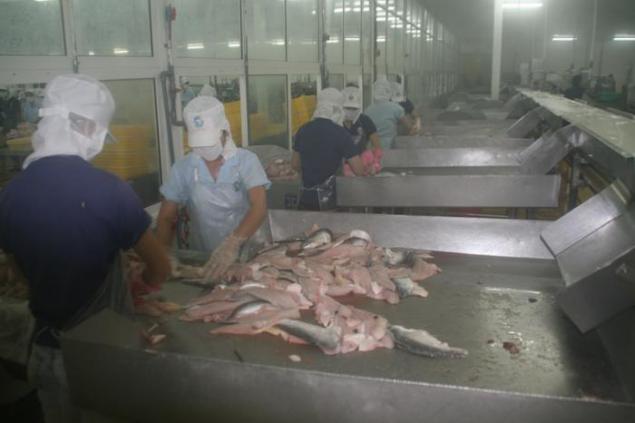
After processing the fish is frozen and packed.
Vietnam mainly produces fillets to Europe. Since pangasius - fish extremely oily, Europe deliver so-called well trimmed fillets (ie - fully cropped). What does it mean? This means that the fillet is removed from the skin, bones, and all the fat, then it looks like this:

Lovely? As for me - very. Only it's not quite like that lies in our stores. The problem is that Russia and Ukraine are buying the most expensive product: Do not cut the fillets (read with all the fat that is there). And it looks (or) like this:
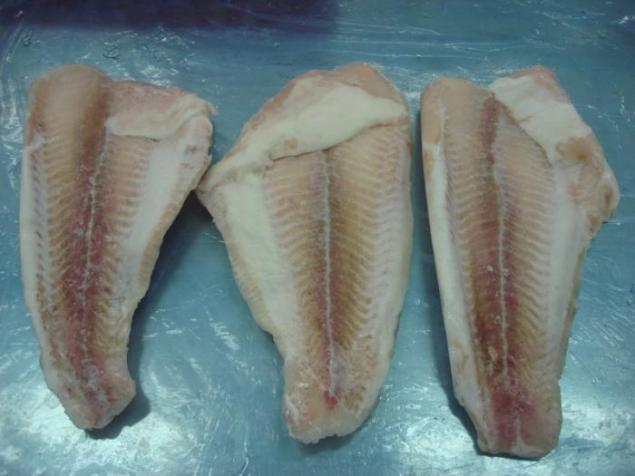
Wrapped strip - this is the biggest piece of abdominal fat, which is wrapped in such a way for compactness. Why, in our stores is the second and not the first? The answer is simple: because the difference between the first and second product from sixty cents to a dollar per kilogram. Throw in a road customs clearance, drifts all public bloodsuckers and get output costs. A wonton in Russia and Ukraine, is positioned as a fish for the poor.
A little bit of what is all of pangasius. From left to right: frozen fillet block, carcass, well trimmed fillets (white color - natural, red - processed fillets) Pangasius portion cubes. Separately, about portions: they are extremely cheap and extremely dumb as: compressed in a portion of the fat trimmed "European" fillets.

The carcass in a vacuum:

Fillet in a vacuum and the substrate rolls:

Now recommendation. In my opinion, Pangasius no better and no worse than a fish farm. Can I eat it? Can. It is certainly no worse than the same "farm" chicken, which Ham medicines. Personally, I did not eat, though import. But do not eat for other reasons: first it is very greasy. Secondly, like any freshwater fish, Pangasius has a specific sweet taste that I do not like.
If you do decide to have a wonton, that:
1. Never take what he wants to take the first fillet. All fillets that were brought to Russia or Ukraine (yes I think that in Europe, too) is injected during the production of a special compound. For what? To increase the weight naturally. Manufacturers claim that these chemicals are harmless, but you hunt to push a harmless chemicals, and even their own money? I do not recommend you do that. Plus, there are so-called "gleyzing" - covering the frozen fish ice crust. The frosting is nothing wrong: a thin crust of ice protects the product from chapping. However, some importers abuse gleyzingom: percentage of water sometimes reaches 30%. So if you see us in some extremely cheap product - do not be fooled. Miracles do not happen. The more fish, the better it is.
Here are photos of fillet which we import:
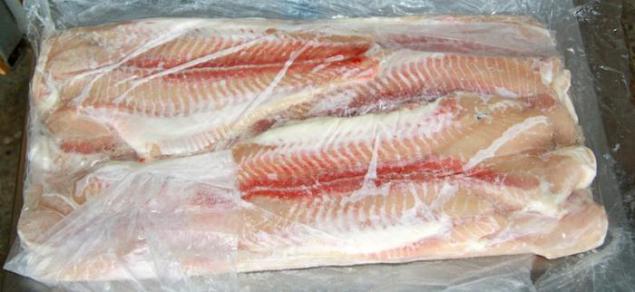
Yes, it is injected (as well as 100% of what is in your store). But water on it only 3%. This is the minimum that is technologically possible to cheat on the product.
2. If you still want to buy Pangasius, take a steak or carcass. The production technology is such that the carcass be injected or steak can not be. Accordingly, you take the product for the money, which he is. When choosing a look at how much ice on the product: remember again - there are no miracles. The more fish the better it is.
Carcass. On the left - the wrong version (the humerus and ten percent of the ice). Right - the correct version: without the humerus and with an acceptable amount of frosting.

Below is a photo of steak which we import. The maximum pure product (as far as can ever be pure pangasius). To steak looked good and was convenient for cooking, it should be cut only after the carcass was frozen. Then it looks like:
All.

Source:
27 photos + a bit of letters. End outline the
Hello my dear true friends! From today, I (as promised) begin to share with you information about fish and seafood. And because the comments I was asked to start from pangasius - begins with him.
Roughly all imported fish can be divided into two categories: wild (hake, hoki, kingklip, pollock, etc.) and farmed (salmon, sea trout (that which Oncorhynchus mykiss), tilapia, catfish and Taiwan, etc.) . Pangasius belongs to the second group, and is probably the most massive artificially produced fish. In the original photo as the time it is (similar to some river pig - but not the pig snout penny).
Pangasius (this is also important) is a freshwater fish and is produced mainly in Vietnam. Without exception, all production (all without exception, companies monsters) are located in the Mekong Delta.
About twenty years ago in Vietnam it began production of pangasius farming, although it was oriented to the domestic market (which is not surprising when more than eighty million population). Eleven years ago, we began to export pangasius, which is very beneficial to the industry: over the years the company emerged in Vietnam concentrate in their hands a complete production cycle (from fry to the final product) and a population of twenty thousand workers in the season.
Immediately apologize for the quality of photos shot exclusively for themselves and not rely on the fact that I ever have to publish them.
Mekong - to put it mildly is not the cleanest river. Swim there, I would not dare. Perhaps this is one of the reasons due to which the pangasius in the world is very cautious attitude.

...

...

...

Water for the production of pangasius really taken from the Mekong, but the fish are not growing in the river, and in a specially dug ponds. There it is cleaned and aerated. Ponds of great variety.

Like any farming fish pangasius feed special pellets. The composition of the pellets include fish waste (which in general is normal, because the fish in the river and the sea eats other fish without harm to health), minerals, and often wastes from the production of sunflower oil (in common - cake). At the time, I was pretty surprised when I learned that one of Norway's largest manufacturers of feed for fish farming, imports cake (thousands of tons) from Ukraine.
Unlike Norway and Chile, where kormёzhka done automatically (or semi-automatic) process in Vietnam everything is done manually. Bags of food are loaded on a raft.

Severe Vietnamese men pull the raft in the middle of the pond.

Then start throwing shovels pellets into the water.

The water at this moment begins a natural way to "boil" of wanting to eat. Oh, they know what they are fed ...

...

...

...

Pangasius - a fast growing fish. Unlike salmon, which from the time of planting the fry into the water, to the bottom grows two to three years, Pangasius grows only six months. After dialing the required weight, the fish is removed from the pond and in a specially equipped car (all this time the fish is in the water, which is fed oxygen) supply to the factory.
It looks something like this:

Almost all operations are carried out manually. This Vietnamese plants like the Chinese (as opposed to Norway, where mechanized almost everything).

Pangasius clog specially trained guys with knives. One shot somewhere near the gills - and the fish die in a special boiler with chilled water. After that, other specially trained men cut fish fillets. Filleting pound fishes usually takes two or three seconds. Head with ridges or melyatsya flour, or used for the production of the same fish feed.
In all plants the most severe sanitary norms. Clean incredible. Any European client who comes to inspect production, looks somewhere so (for clarity, placed next to the representative of the indigenous people):

Biorobot:

...

One of the few operations that are not done by hand: the removal of the skin from the fillets. Sliced manually fillet served here, and the two lad put him on a special roll. The skin is not always cut cleanly, then it was trimmed by hand.

...

After processing the fish is frozen and packed.
Vietnam mainly produces fillets to Europe. Since pangasius - fish extremely oily, Europe deliver so-called well trimmed fillets (ie - fully cropped). What does it mean? This means that the fillet is removed from the skin, bones, and all the fat, then it looks like this:

Lovely? As for me - very. Only it's not quite like that lies in our stores. The problem is that Russia and Ukraine are buying the most expensive product: Do not cut the fillets (read with all the fat that is there). And it looks (or) like this:

Wrapped strip - this is the biggest piece of abdominal fat, which is wrapped in such a way for compactness. Why, in our stores is the second and not the first? The answer is simple: because the difference between the first and second product from sixty cents to a dollar per kilogram. Throw in a road customs clearance, drifts all public bloodsuckers and get output costs. A wonton in Russia and Ukraine, is positioned as a fish for the poor.
A little bit of what is all of pangasius. From left to right: frozen fillet block, carcass, well trimmed fillets (white color - natural, red - processed fillets) Pangasius portion cubes. Separately, about portions: they are extremely cheap and extremely dumb as: compressed in a portion of the fat trimmed "European" fillets.

The carcass in a vacuum:

Fillet in a vacuum and the substrate rolls:

Now recommendation. In my opinion, Pangasius no better and no worse than a fish farm. Can I eat it? Can. It is certainly no worse than the same "farm" chicken, which Ham medicines. Personally, I did not eat, though import. But do not eat for other reasons: first it is very greasy. Secondly, like any freshwater fish, Pangasius has a specific sweet taste that I do not like.
If you do decide to have a wonton, that:
1. Never take what he wants to take the first fillet. All fillets that were brought to Russia or Ukraine (yes I think that in Europe, too) is injected during the production of a special compound. For what? To increase the weight naturally. Manufacturers claim that these chemicals are harmless, but you hunt to push a harmless chemicals, and even their own money? I do not recommend you do that. Plus, there are so-called "gleyzing" - covering the frozen fish ice crust. The frosting is nothing wrong: a thin crust of ice protects the product from chapping. However, some importers abuse gleyzingom: percentage of water sometimes reaches 30%. So if you see us in some extremely cheap product - do not be fooled. Miracles do not happen. The more fish, the better it is.
Here are photos of fillet which we import:

Yes, it is injected (as well as 100% of what is in your store). But water on it only 3%. This is the minimum that is technologically possible to cheat on the product.
2. If you still want to buy Pangasius, take a steak or carcass. The production technology is such that the carcass be injected or steak can not be. Accordingly, you take the product for the money, which he is. When choosing a look at how much ice on the product: remember again - there are no miracles. The more fish the better it is.
Carcass. On the left - the wrong version (the humerus and ten percent of the ice). Right - the correct version: without the humerus and with an acceptable amount of frosting.

Below is a photo of steak which we import. The maximum pure product (as far as can ever be pure pangasius). To steak looked good and was convenient for cooking, it should be cut only after the carcass was frozen. Then it looks like:
All.

Source:
